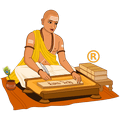























Sunrise05:53
Sunset20:24
Moonrise21:48
Moonset06:25
Shaka Samvat1926 Tarana
Vikram Samvat2061 Hemalambi
Gujarati Samvat2060 Manmatha
Amanta MonthAshadha
Purnimanta MonthShravana
WeekdayShaniwara
PakshaKrishna Paksha
TithiPratipada upto 11:51
NakshatraPurva Ashadha upto 06:56
NakshatraUttara Ashadha upto 28:08+
YogaIndra upto 10:32
KaranaKaulava upto 11:51
KaranaTaitila upto 22:01
Pravishte/Gate20
Rahu Kalam09:31 to 11:20
Gulikai Kalam05:53 to 07:42
Yamaganda14:57 to 16:46
Abhijit12:39 to 13:38
Dur Muhurtam05:53 to 06:51
Dur Muhurtam06:51 to 07:49
Amrit Kalam22:29 to 23:54
Varjyam14:00 to 15:25
Notes: All timings are represented in 24+ hour notation in local time of Tehran, Iran with DST adjustment (if applicable).
Hours past midnight are higher than 24:00 and fall on next day. In Panchang day starts and ends with sunrise.


 Kanya 10:11
Kanya 10:11 Chitra 21:44
Chitra 21:44

 Tula 12:52
Tula 12:52 Vishakha 18:18
Vishakha 18:18

 Kumbha
Kumbha Shatabhisha 22:51
Shatabhisha 22:51

 Kumbha 16:33
Kumbha 16:33 P Bhadrapada 22:34
P Bhadrapada 22:34

 Meena
Meena U Bhadrapada 23:09
U Bhadrapada 23:09

 Meena 24:32+
Meena 24:32+ Revati 24:32+
Revati 24:32+

 Mesha
Mesha Ashwini 26:37+
Ashwini 26:37+

 Mesha
Mesha Bharani 29:15+
Bharani 29:15+

 Mesha 11:58
Mesha 11:58 Krittika
Krittika

 Mithuna
Mithuna Mrigashira 14:22
Mrigashira 14:22

 Karka 24:28+
Karka 24:28+ Ashlesha 24:28+
Ashlesha 24:28+

 Simha
Simha Magha 26:12+
Magha 26:12+

 Simha
Simha P Phalguni 27:32+
P Phalguni 27:32+

 Simha 09:48
Simha 09:48 U Phalguni 28:26+
U Phalguni 28:26+

 Kanya
Kanya Hasta 28:50+
Hasta 28:50+

 Kanya 16:50
Kanya 16:50 Chitra 28:41+
Chitra 28:41+

 Tula
Tula Swati 27:59+
Swati 27:59+

 Tula 21:04
Tula 21:04 Vishakha 26:42+
Vishakha 26:42+

 Vrishchika
Vrishchika Anuradha 24:54+
Anuradha 24:54+

 Dhanu 22:42
Dhanu 22:42 P Ashadha 17:23
P Ashadha 17:23In Hindu Calendar, the day starts with local sunrise and ends with next day local sunrise. As sunrise time is different for all cities, Hindu Calendar made for one city is not valid for any other city. Hence it is important to use location based Hindu Calendar, like this website. Further, each Hindu day consists of five elements, which are called angas. These five elements are -
In Hindu Calendar, all five elements together are called Panchang. (In Sanskrit: Panchang = Pancha (five) + Ang (part)). Hence Hindu Calendar which shows all five elements for each day is called Panchang. In South India Panchang is known as Panchangam.
When Hindu Calendar includes Muslims, Sikh, Christian, Buddhist and Jain festivals, including national holidays, it is called as Indian Calendar.